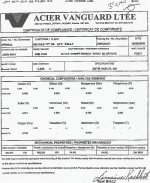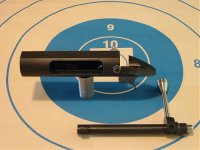G'day all.
I have gone as far as i can with my other projects for the moment and i'm looking at having a crack at building an action from the ground up.
Has anyone here actualy built there own action?
Probably sounds crazy to most but i am seriously considering this.
Second hand Rem actions are getting very hard to find for a reasionable price here in Australia. And the cost of importing a custom action quickly gets out of hand when you consider the Aussie Dollar, 30% import duty, customs stamp dutys etc, then another 10% for the dealers cut. A $1000 USD action comes in at about $1650 AUD. Not to mention all the paperwork to do this!!I'm sure i can build an action for less than this.
Looking at a remington 700 action, the machining looks pretty straight forward. One thing that did have me wondering is how the internal locking lug
ramp/helix are cut?
Would i be better off going for a rebated 3 Lug design, negating the need to cut lug racways in the receiver? Or just stick to the 2 lug design and EDM the raceways?
I'm a machinist by trade and have access to a good manual lathe, CNC 4 axis mill, slotting/broaching machine. I also have a mate who works in the tool and die industry and has access to CNC EDM/wire cutter.
Realy after some general info, hints and tips/ traps and pittfalls.
Looking at using 4140 or 4340 for the receiver as i like the look of Blued steel over stainless. Can anyone recomend a material for the bolt?
Also some info on correct heat treatment? I read somewhere that the receiver should be heat treated to 38 Rc?? Then finish machined..
Cheers
Leeroy
I have gone as far as i can with my other projects for the moment and i'm looking at having a crack at building an action from the ground up.
Has anyone here actualy built there own action?
Probably sounds crazy to most but i am seriously considering this.
Second hand Rem actions are getting very hard to find for a reasionable price here in Australia. And the cost of importing a custom action quickly gets out of hand when you consider the Aussie Dollar, 30% import duty, customs stamp dutys etc, then another 10% for the dealers cut. A $1000 USD action comes in at about $1650 AUD. Not to mention all the paperwork to do this!!I'm sure i can build an action for less than this.
Looking at a remington 700 action, the machining looks pretty straight forward. One thing that did have me wondering is how the internal locking lug
ramp/helix are cut?
Would i be better off going for a rebated 3 Lug design, negating the need to cut lug racways in the receiver? Or just stick to the 2 lug design and EDM the raceways?
I'm a machinist by trade and have access to a good manual lathe, CNC 4 axis mill, slotting/broaching machine. I also have a mate who works in the tool and die industry and has access to CNC EDM/wire cutter.
Realy after some general info, hints and tips/ traps and pittfalls.
Looking at using 4140 or 4340 for the receiver as i like the look of Blued steel over stainless. Can anyone recomend a material for the bolt?
Also some info on correct heat treatment? I read somewhere that the receiver should be heat treated to 38 Rc?? Then finish machined..
Cheers
Leeroy



